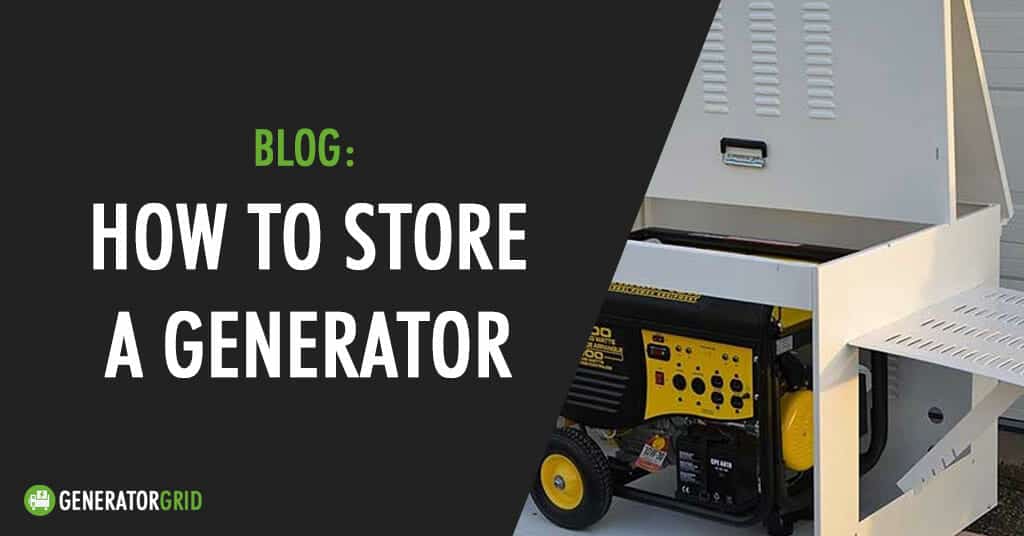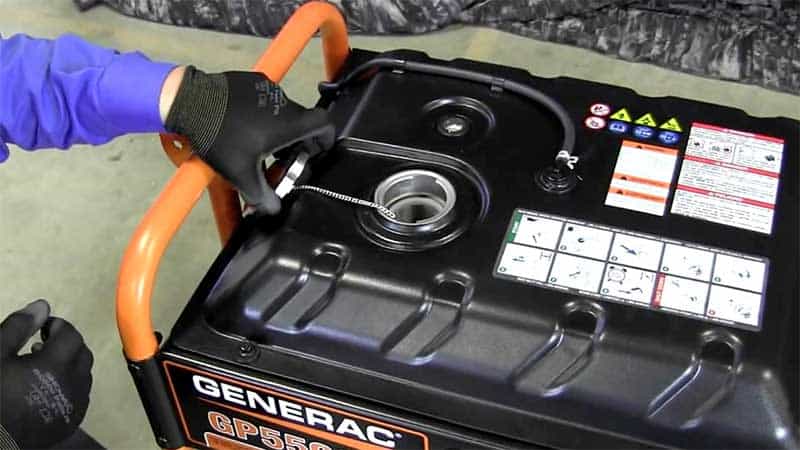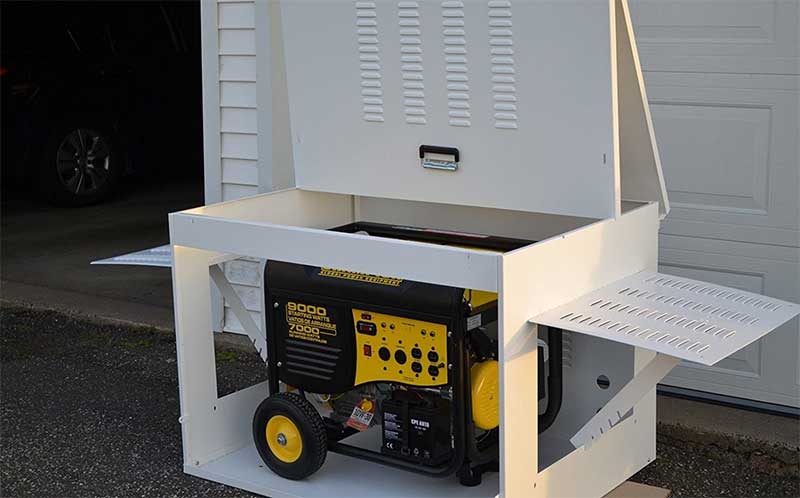Last Updated on July 25, 2022 by Manager Access

Did you know that how you store your generator will determine how long it will work or if it can even be used again?
Knowing how to care for and store your portable generator can be a big deal.
In this article, we will go over how to store your portable generator and what you can do to keep it running well for the long haul.
How to store a portable generator?
To extend the life of your portable generator, you need to empty its fuel tank and fuel lines and keep it in a cool dry place. Generator sheds, tents, and covers are available to help make storing and protecting your portable generator easier.
Understanding how to take care of your portable generator requires more than just knowing that you need to remove unused gasoline, though.
You need to understand the storage requirements for different types of portable generators and what you can do to extend the life of the fuel left in your tank if drainage isn’t a convenient option.
Below, we will go over everything you need to know about storing your portable gas or propane generator.
Generators Must Be Cleaned and Drained of Fuel Before Long-Term Storage

If you are using a portable generator that runs primarily off of gasoline, it’s very important that you remember to remove any excess fuel from its tank and fuel lines before storing it.
You may also want to clean your carburetor out.
Short-Term Storage
If you’re only going to store your generator for a week or so, you can leave any gasoline in the tank.
However, after about 10 days, the gas in your fuel lines and tanks can start to cause corrosion.
This could clog and ultimately ruin your carburetor.
I suggest draining out your gas and then cleaning your carburetor.
Propane Generators
Propane and Dual-Fuel Generators aren’t as hard to prep for storage.
If your generator has been running off of only propane, you won’t have to worry about cleaning out your carburetor, fuel lines, or tank.
Propane burns pretty clean and won’t leave excessive residue in your generator the way that gasoline will.
Some generators can be run with propane or gasoline. If you aren’t sure when the last time you used gas in your generator was, I recommend cleaning it out completely just in case.
Cleaning Your Carburetor
You can clean your carburetor by removing it, taking it apart, and treating it with either carb cleaner or putting it into an ultrasonic cleaning machine.
Using a Fuel Stabilizer to Avoid Draining the Tank

There are some fuel stabilizers out there that can prolong the life of the gas in your generator.
If you don’t want to waste gas or drain your tank and fuel lines, you can add a properly formulated fuel stabilizer before storage.
These will keep the gas in your tank good for up to a year, depending on the climate and conditions that your generator has been exposed to.
I personally don’t recommend trying to use gas that has been treated with a fuel stabilizer after 8 months.
The most popular fuel stabilizer by far is the Sta-bil Red Fuel Stabilizer.
Some of the Best Storage Options for Portable Generators
I’ll give you a few of my favorite generator storage solutions. Ultimately, you’re going to want to keep your generator clean, dry, and at a stable temperature.
Here are some of the best ways to accomplish this.
Use a Mini Storage Shed
You don’t need to use a gigantic storage shed to store your portable generator.
In fact, large wooden sheds that haven’t been properly maintained aren’t a good place for your generator anyway; they let can let in too much moisture.
Storing your portable generator is more about keeping it dry and at a stable temperature than anything else.
There are many small storage sheds that have been specifically designed to store small machinery like a portable generator.
Check Out Generator Covers and Hoods

If you’re going to be storing your generator in the garage, you’re on the right track.
Just remember, if you want to be able to drive your vehicles into your garage and park them, you’ll need to think about what they might track in.
Anyone who lives in an area that sees lots of snowfall knows the struggle presented by melting snow and mud that sticks to your vehicle.
The solution? Get a generator cover. These covers will allow you to safely store your generator in your garage if you live in a cold climate.
In temperate regions, you can even store your generator on the porch is you use a portable generator enclosure.
3 Solutions For All-Weather Outside Storage
Now that you know what options and storage solutions are available to you, I’ll give you a few specific products to look at.
These three enclosures can be used to store your generator outside in all kinds of weather.
1. Microfab Portable Generator Enclosure
This enclosure is probably my favorite solution.
It’s very easy to set up and has been specifically engineered to keep your generator safe and secure. It keeps out moisture, dirt, debris, and more.
It also is great for when you need to actually use your portable generator.
Since the sides lift up, you can actually use your generator while it’s in the enclosure.
It’s ventilated so that exhaust can escape easily without letting in moisture as well.
This enclosure is constructed of powder-coated aluminum to reduce corrosion and weight.
2. Suncast Horizontal Storage Shed
This outdoor storage shed is just the right size for your generator.
It’s durable, functional, and affordable. The multi-wall resin panels are designed to be impact-resistant and sturdy.
The all-weather construction provides impressive water resistance and UV protection while simultaneously maintaining the appearance of the shed.
It also locks, which is important for the security of your generator.
3. The Rubbermaid Horizontal Storage Shed
This is a mini storage shed that has been specifically designed to keep things safe from any inclement weather.
It measures 36 x 55 x 28 inches. Inside, it’s 29 x 47 x 21 inches.
It won’t rust, it won’t corrode, it has no holes, and it does a great job of keeping out external factors like rain, snow, and heat.
Why Is Storing Your Generator Correctly So Important?
Your portable generator can be a true lifesaver in a power outage or in areas where climate conditions are unfavorable.I can’t tell you how many times my generators have come in handy at work and at home but none of my generators would have been any good if I hadn’t figured out how to store them properly.
Storing your generator correctly will not only help to ensure that it’s ready to be used when an emergency crops up but it will also keep you safer when you operate it.
Storing your generator properly will shelter it from external factors like humidity, snow, and rain; plus, you’ll be able to prevent rust, corrosion, and the buildup of dust and dirt in its mechanical components.
When most people go out and get a portable generator, they usually don’t think a lot about how they’re going to store it.
While sticking your generator on your back porch or keeping it out in a workshed might seem like a decent plan, neither of these solutions is ideal.
Generators are like any other piece of equipment; they’re prone to rust, corrosion, and temperature fluctuations.
To store your generator properly, you’ll need to know what type of generator you have, which kind of fuel you’ll be using, and how the weather in your area will impact its circuitry and mechanical components.
Take Your Climate Into Consideration

The climate in your area will be a big factor to consider when storing your generator.
For instance, someone using a propane generator and living in an arid place like Phoenix, AZ, could probably keep their generator protected simply by placing it in an air-conditioned garage and covering it with a tarp.
However, if their garage got pretty hot, they’d need to find another solution.
Someone living in a humid and rainy place like Portland, Oregon wouldn’t need to worry about heat as much but would definitely need to take all of that rain into consideration.
The big enemies to your generator are rain, snow, excessive heat, and below-freezing temperatures.
These factors can cause your generator to malfunction or stop running altogether.
Hot Climates
If you live in an excessively hot place, store your generator somewhere that’s cool. Too much heat can cause big issues with your fuel lines, even in the short-term.
This is especially true if you’ve got any excess fuel in your tank.
Cold Climates
The cold won’t impact your generator too much. If the temperature drops below freezing, however, you run the risk of fuel freezing in your fuel lines.
Melted snow can also cause rust and corrosion.
Wet Climates
Generators are made of metal. Metal corrodes and rusts when it gets wet.
If you’re living in an area with lots of rain, snow, or humidity, you’ll need to figure out how to keep your generator dry while it’s being stored.
How Long Can I Store My New Generator?
If you’ve never used your portable generator before, you may be wondering how long you can store it.As long as you oil down the cylinder walls to prevent the rings from sticking and rust forming, you should be able to store it for a few years.
Adding crankcase oil may also be wise to help preserve the components of your generator.
Keep in mind that rubber gaskets will start to weaken over time. You may want to have a few spare gaskets on hand if you’re planning on keeping your new generator for years without using it.
That way, when an emergency comes up, you’ll be able to get it working no matter what.
Conclusion
Storing your generator correctly is important.
A correctly stored and maintained generator will be more reliable if you find yourself in a power outage situation.
What are your thoughts? Do you have any generator storage tips that I have forgotten to include? Please feel free to comment, share, and leave your feedback!

Scott Krager purchased generatorgrid.com in the summer of 2020 and quickly began to buy every generator under the sun! He currently has over a dozen generators and the number is growing quickly. He lives in Portland, OR near his family and friends.
GeneratorGrid.com is an independent review business. I am not affiliated with any manufacturers and do not accept paid reviews. When you buy through my links, I may earn a commission which helps me purchase more generators for testing. - Scott Krager


I have a Generac 10000 generator.
Can anyone show me or exactly write to me how to change the air filter.
It is not like others.
It is placed between the top of the engine block and the fuel tank, less than an inch space in between and impossible to remove. Lifting up the gas tank to make room is impossible because of the rigid steel frame.
All generators online are with such information except the Generac 10000.
Help much appreciated
One major point I will add to this article, is regardless of where you store it, buy yourself a large chain and a good quality pad lock or a good quality cable lock and lock them down to something solid, even if it’s put away in your garage, they seem to grow legs in the middle of the night and walk away.
I also buy more then one pad lock so I can lock the power cord to the chain or generator frame, so if someone is so determend to steal it they can buy the new twistlock ends for it cause the only way to get it free is to cut the moulded ends off, and five gallon buckets also make nice waterproof cord storage containers, the home depot ones are even color matched to generac generators.
I have a 3550 watt generator I want to store it in my 10×8 storage shed tin it gets hot were I’m from in the summer is that ok to store my generator thanks